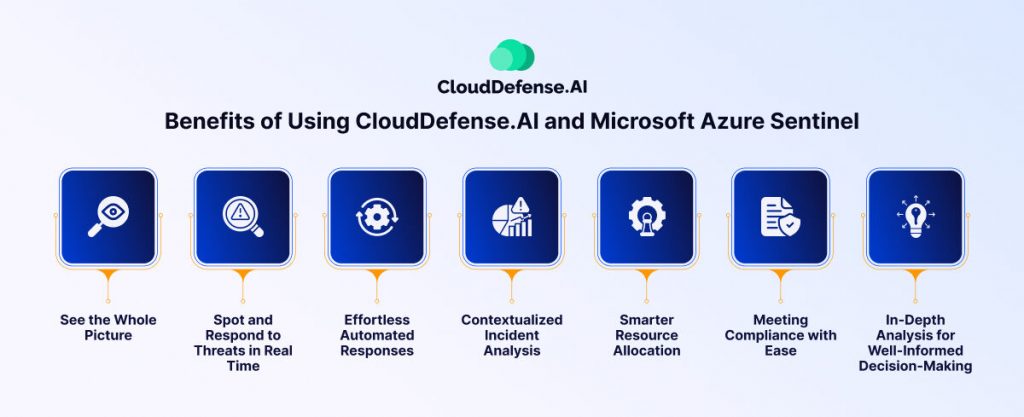Every single piece of information generated from organizational operations holds the potential to reveal valuable security insights. Yet the challenge persists in deciphering and comprehending the vast expanse of data. Fortunately, a solution is on the horizon, and this blog aims to guide you through the intricacies of integrating two powerful tools – Azure Sentinel and CloudDefense.AI.
Microsoft’s Azure Sentinel, a cloud-native SIEM (Security Information and Event Management) solution enables organizations to collect, analyze, and respond to security threats in real-time. On the flip side, CloudDefense.AI is the comprehensive CNAPP that secures cloud infrastructure and applications. Imagine the remarkable synergy that will emerge by combining the strengths of both.
With that in mind, this blog guides you on integrating Microsoft Azure Sentinel with CloudDefense.AI, offering a unified strategy to enhance your security posture. By bridging these two robust platforms, organizations can leverage the strengths of each to create a holistic security ecosystem that not only detects and responds to threats but also secures the entire cloud and application architecture.
What is Azure Sentinel?
Azure Sentinel is a cloud-native Security Information and Event Management (SIEM) service brought to you by Microsoft Azure. Its mission is to empower organizations, giving them the upper hand in detecting, investigating, and responding to security threats that may lurk across their entire enterprise. How does it do this? Basically, it gathers and checks tons of data from different places, like logs and telemetry, to keep an eye on everything. It’s your go-to place for managing and monitoring security stuff.
But what’s great about it? Well, it doesn’t just spot issues; it’s got these super smart features that can figure out suspicious activities and potential security problems right when they happen. Imagine having the ability to customize dashboards and set up automatic responses—Azure Sentinel makes that a reality.
Moreover, it’s not like one of those one-size-fits-all deals. Azure Sentinel can flex and adapt, teaming up seamlessly with other Azure services and outside security tools. It’s like a complete package for modern cybersecurity, blending in effortlessly to provide that extra layer of protection. So, if you’re looking for a security solution that’s not just effective but also plays nice with everything else, Azure Sentinel might just be your cybersecurity ally!
Benefits of Using CloudDefense.AI and Microsoft Azure Sentinel

See the Whole Picture:
When CloudDefense.AI and Azure Sentinel collaborate, the organizations have a comprehensive perspective on their security environment. With advanced threat detection that Azure Sentinel offers, and CloudDefense.AI’s deep insights concerning application and cloud protection, there is a comprehensive view of potential threats throughout the entire digital infrastructure.
Spot and Respond to Threats in Real Time:
Azure Sentinel is excellent at real-time threat detection, using AI-driven analytics to promptly identify and respond to security incidents. Integrating CloudDefense.AI takes this capability up a notch by providing real-time insights into application vulnerabilities and cloud infrastructure. This proactive approach allows organizations to address security concerns before they become bigger issues.
Effortless Automated Responses:
CloudDefense.AI and Azure Sentinel integrate so well that they can automatically generate response actions. For instance, if Azure Sentinel identifies a suspected threat, Clouddefense.AI can automatically trigger security actions such as isolating susceptible applications or applying predefined cloud security policies. This removes the need for manual intervention and also reduces response time.
Contextualized Incident Analysis:
Azure Sentinel is great at pulling together and connecting vast amounts of security data. This joint solution, relying on CloudDefense.AI’s intelligent application security contextual information, upgrades incident analysis. Security teams will be able to go into the details of an incident, which will allow them to learn more about the threat landscape and come up with tailored mitigation strategies.
Smarter Resource Allocation:
CloudDefense.AI assists in the efficient use of resources by identifying threats and vulnerabilities within applications. Combining this information with Azure Sentinel’s centralized monitoring platform allows security teams to better prioritize and allocate resources. Attention is turned to the most risky areas.
Meeting Compliance with Ease:
This combined solution doesn’t just stop at security; it also aids organizations in meeting regulatory compliance requirements. Azure Sentinel’s audit logs and CloudDefense.AI’s application-level security insights come together to simplify the process of generating detailed compliance reports. Demonstrating adherence to industry-specific regulations has never been more straightforward with this collaborative approach.
In-Depth Analysis for Well-Informed Decision-Making:
The collaboration between CloudDefense.AI and Azure Sentinel guarantees that security incidents undergo a contextualized analysis. By correlating application-level security data with comprehensive threat intelligence, security teams acquire a more nuanced comprehension of incidents, enabling well-informed decision-making and the development of targeted response strategies.
Integrating CloudDefense.AI with Microsoft Azure Sentinel: A Step-by-Step Guide
Step 1: Obtain API Key from CloudDefense.AI
- Go to https://console.clouddefenseai.com/profile-management to generate your API key.
Step 2: Configure Microsoft Management Agent (MMA)
- Access your Azure Sentinel dashboard and locate the Microsoft Management Agent (MMA) feature.
- Set up MMA to establish a connection between Azure Sentinel and CloudDefense.AI.
Step 3: Configure HTTP Data Source in Azure Sentinel
- Create an HTTP Data Source in Azure Sentinel.
- Use the following API endpoint to retrieve a list of vulnerabilities for a specific application: https://console.clouddefenseai.com/api-v2/integrations/application/584174528
- Include the API key in the request header with the key “apikey.”
Step 4: Customize Parser/Schema in Azure Sentinel
- Define your parser/schema within Azure Sentinel to extract key/values from the JSON response obtained from CloudDefense.AI.
- Tailor the parser to access specific information such as vulnerability details, severity levels, and affected applications.
Step 5: Validate and Test
- Ensure that the integration is functioning correctly by validating the configuration.
- Conduct tests to retrieve and display a list of vulnerabilities in your Azure Sentinel dashboard.
FAQ
1. Is Azure Sentinel the same as Microsoft Sentinel?
Yes, Azure Sentinel and Microsoft Sentinel are the same product. “Azure” is often used in front of Microsoft services that run on the Azure cloud platform, but the core product and functionality remain the same. You can use either name interchangeably.
2. Is Azure Sentinel a tool?
Yes, Azure Sentinel is a cloud-based security information and event management (SIEM) tool. It helps organizations collect, analyze, and visualize security data from various sources to identify and respond to potential threats.
3. Is Sentinel better than Splunk?
Deciding whether Sentinel is “better” than Splunk depends on your specific needs and priorities. Both platforms are powerful tools for log management and analysis, but they have different strengths and weaknesses. Choose Sentinel if you prioritize ease of use and scalability and have a moderate budget. Choose Splunk if you need maximum flexibility, customization, advanced reporting, and analysis capabilities.
Conclusion
To wrap up, integrating Azure Sentinel with CloudDefense.AI is a great way to enhance your organization’s security posture. Since you combine the strengths of both platforms, you can actually create a holistic security ecosystem that detects and responds to threats, secures your cloud and application architecture, and provides valuable security insights.
But this isn’t just a passive defense. This is proactive security, empowering you to predict, prevent, and outsmart your adversaries. And remember, the journey doesn’t end here. Keep exploring, keep integrating, and keep refining your defenses. Because when it comes to cybersecurity, vigilance is your ultimate weapon.







